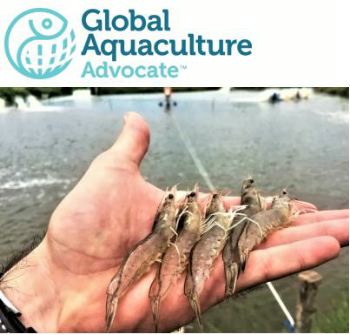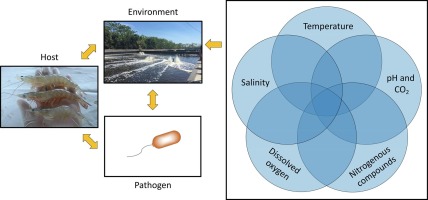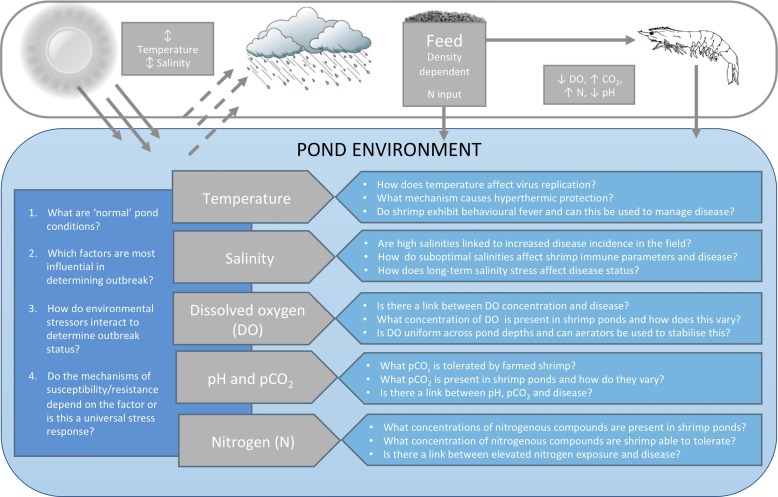|

Authors evaluated the influence of various abiotic environmental conditions on shrimp susceptibility to White Spot Disease (WSD) Photo by Fernando Hu
Influence of stressors on shrimp susceptibility to White Spot Disease, Part 1
 UNITED STATES
UNITED STATES
Wednesday, April 21, 2021, 06:00 (GMT + 9)
ADMIN SEThe following is an excerpt from an article published by the Global Aquaculture Advocate:
Evidence for links between abiotic environmental conditions and WSD outbreaks reviewed: temperature and salinity
Six viral diseases of crustacea (including White Spot Disease, YWSD; Yellow Head Disease, YHD; and Taura Syndrome, TS) are currently listed by the World Organisation for Animal Health (OIE), recognizing their potential to cause substantial economic loss and spread to shrimp farming and trading countries. Of these, the greatest threat to shrimp aquaculture worldwide is WSD, caused by the White Spot Syndrome Virus (WSSV). This single disease has reportedly caused an estimated (U.S.) $21 billion in economic damage since its emergence was detected in 1992.

Graphical abstract
WSSV infection affects both wild and farmed shrimp populations, but its impacts are most significant within intensive aquaculture settings, where animals are reared at unnaturally high densities. Most reviews thus far have focused on host physiology and molecular responses to infection, nutrition and feed enhancement, and the application of probiotics to prevent disease outbreaks. However, WSD outbreaks are increasingly associated with changes in environmental conditions that may lead to physiological stress and a compromised ability of shrimp to resist disease. Changes in water temperature, salinity, oxygen levels and pH are particularly important to ensure good animal health in aquaculture systems and managing water quality remains a challenge for many shrimp farms.
It is important that the relationship between disease susceptibility and environmental abiotic conditions are determined, as suboptimal conditions within shrimp farms may promote infection, leading to increased losses across farms. Moreover, there may be practical solutions relating to improvements in specific pond conditions that could serve to reduce the rates of shrimp diseases.
This article – adapted and summarized from the original publication (Millard, R.S. et al. 2020. How do abiotic environmental conditions influence shrimp susceptibility to disease? A critical analysis focused on White Spot Disease. Journal of Invertebrate Pathology, April 2020) – reports on a comprehensive review that critically evaluated evidence from the literature on the effects of alterations in abiotic environmental conditions on the occurrence and severity of WSD outbreaks.
 and thermal tolerance and optimal replication ranges of White Spot Syndrome Virus (WSSV) (red).jpg)
Thermal ranges for shrimp growth and WSSV replication. Thermal tolerance and optimal growth ranges of L. vannamei shrimp (blue) and thermal tolerance and optimal replication ranges of White Spot Syndrome Virus (WSSV) (red). The abbreviations on the figure represent critical thermal minima (CTMin) and critical thermal maxima (CTMax). (For interpretation of the references to color in this figure legend, the reader is referred to the web version of this article).
Study setup
For each abiotic parameter considered in this review, we summarized the available information on their effects on penaeid shrimp physiology, evaluated evidence for altered WSD outbreak occurrence or severity and discussed some of the mechanisms that may lead to altered susceptibility (e.g., compromised immune response).
In this review we also considered the potential for conditions in aquaculture systems to be optimized for disease prevention, given their importance as predictors of outbreaks. And we additionally identified areas in which further research will facilitate our understanding of disease dynamics and implementation of practical solutions to the problems caused by WSD in an aquaculture setting.
Detailed information on the literature reviewed on WSD, WSSV temperature, salinity, dissolved oxygen concentration, hypercapnia [buildup of carbon dioxide in the body of an organism] and pH, and nitrogenous compounds; and their relevance to shrimp farming, refer to the original publication.

Critical knowledge gaps in the influence of abiotic environmental factors on penaeid shrimp physiology and White Spot Disease susceptibility. The top panel presents factors that contribute to the variation of abiotic conditions within ponds. Knowledge gaps relating to how exposure to changes in environmental factors affects WSD are identified on the left panel. In the right panel we present three critical research questions for each environmental factor discussed within this review, which we consider to be priorities in future research.(click image to enlarge)
Temperature
Shrimp are typically reared in enclosed, shallow ponds where low levels of water exchange coupled with tropical weather conditions allow for significant seasonal and diurnal fluctuations in water temperature to occur. The most commonly farmed penaeid shrimp, the Pacific white shrimp (Litopenaeus vannamei), is able to tolerate wide variations in temperature, ranging from 7.5 to 42.0 degrees-C. The optimal temperature for growth of this species is reported to depend on size, with small shrimp (<5 grams) growing most rapidly at 30 degrees-C and larger shrimp (>16 grams) growing most rapidly at >27 degrees-C.
Many farmers have the capacity to measure temperature conditions within shrimp ponds and how they fluctuate; however, this information is typically not openly available. There are published studies that link rapid temperature fluctuations in ponds (changes of a magnitude of 4.2 to 4.5 degrees-C) following a tropical storm with variation in viral loads and disease outbreak occurrence. (continues...)
Author: Rebecca S. Millard Robert P. Ellis, Ph.D. Kelly S. Bateman, Ph.D. Lisa K. Bickley, Ph.D. Charles R. Tyler, Ph.D. Ronny van Aerle, Ph.D. Eduarda M. Santos, Ph.D. / Global Aquaculture Advocate | Read the full article by clicking the link here
editorial@seafood.media
www.seafood.media
|



